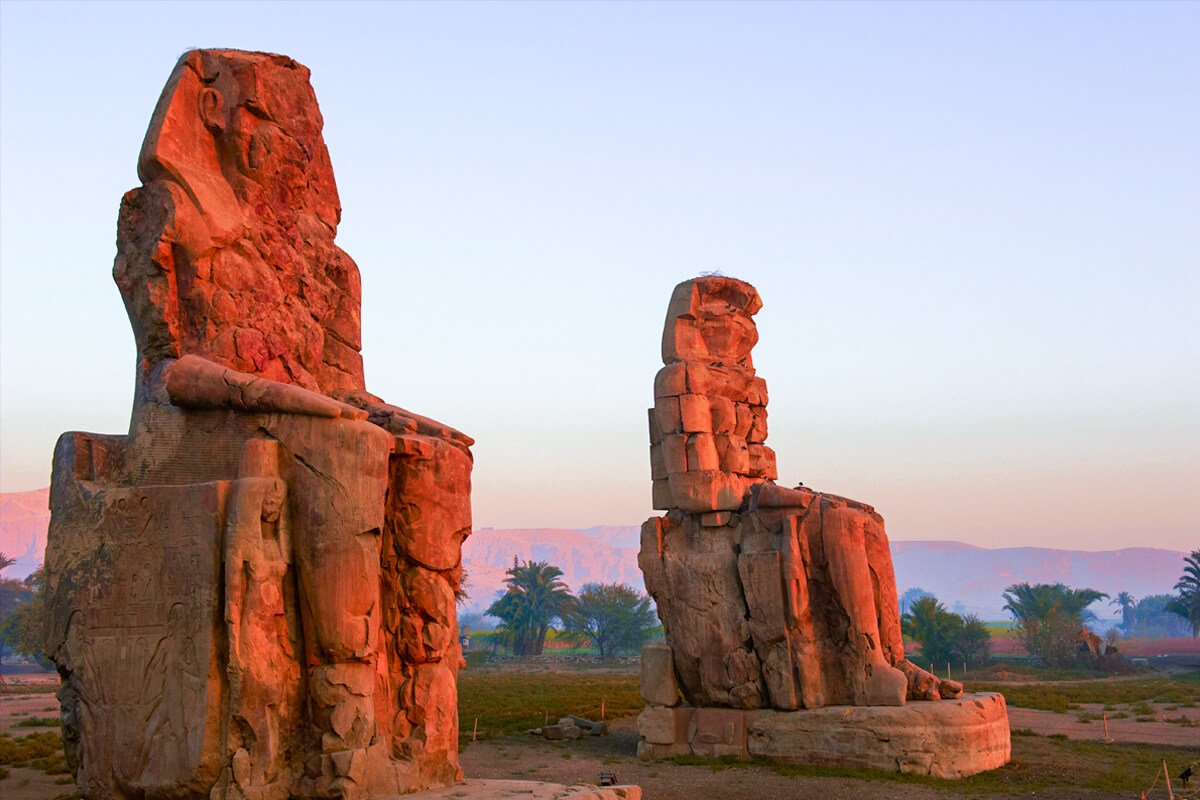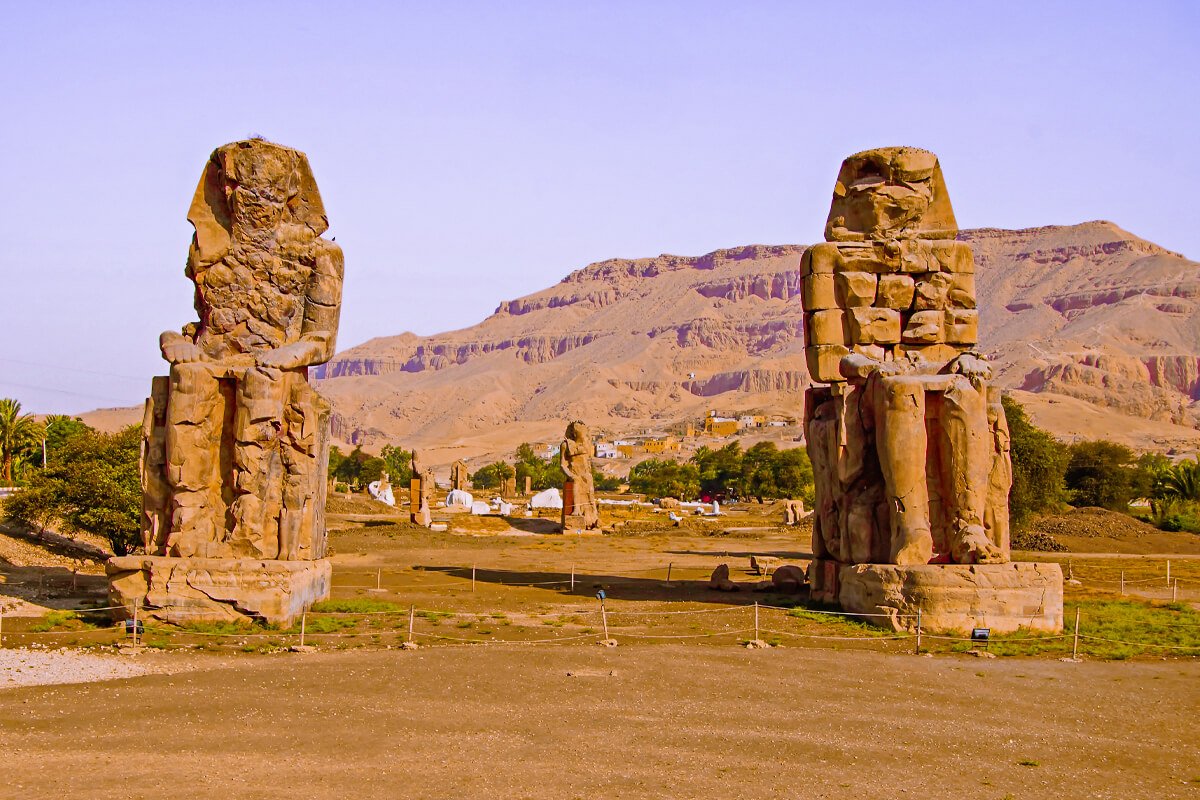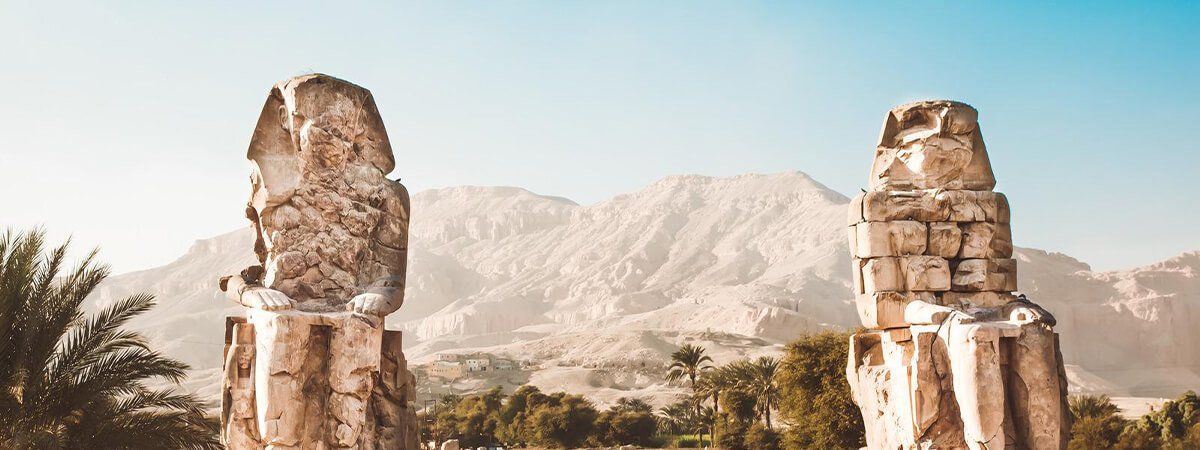The Colossi of Memnon in Luxor: Guardians of a Bygone Era
The Colossi of Memnon in Luxor are not simply stone giants but portals to a mysterious and ancient past. They are an unrivaled site for history fans and curious tourists because of their massive size, elaborate carvings, and the creepy sound phenomena surrounding them.
These watchmen from another time are still standing, and they invite everyone to learn their secrets and appreciate the ancient Egyptians’ lasting contribution to the world. The Colossi of Memnon are quiet sentinels, standing firm in the ever-changing fabric of human history.
Unveiling the Mythical Giants: the Colossi of Memnon
To uncover the mystique of the Colossi of Memnon, one must venture to the sun-kissed lands of Luxor, situated on the eastern bank of the Nile River. These enigmatic behemoths are nestled near the once-mighty Amenhotep III’s mortuary temple, creating a breathtaking tableau of monumental artistry.
- The legend behind the name Memnon
The name “Memnon” itself is steeped in mythological resonance. In ancient Greek lore, Memnon was a hero-king, the son of Eos (the goddess of dawn) and Tithonus, who fought bravely in the Trojan War. His name was aptly bestowed upon one of these colossal statues by the ancient Greeks, and it has endured through the annals of time.
Luxury Nile Cruises – Book Your Relaxation!
What makes these statues so remarkable?
The Colossi of Memnon’s stature is awe-inspiring, each towering over 18 meters in height, chiseled from massive blocks of quartzite sandstone. These imposing figures, carved with precision and artistry, have endured centuries of weathering, tumultuous history, and natural disasters. But what truly sets them apart is their unexpected voice, a phenomenon that has captured the imagination of countless visitors.

The historical context of the New Kingdom period
We must examine the New Kingdom era, the pinnacle of Egyptian civilization and characterized by prosperity, cultural flourishing, and territorial expansion, to understand Colossi’s place in history. Amenhotep III, the pharaoh responsible for these colossal wonders, ruled during this illustrious era when Egypt’s power and influence reached unprecedented heights.
- The purpose and significance of colossal statues in Egyptian culture
Colossal statues, like the Colossi of Memnon, were more than just monuments; they were an intrinsic part of ancient Egyptian culture. They served as symbols of divine power, divine kingship, and the enduring legacy of the pharaohs. These colossal guardians were believed to protect and watch over the temples, acting as intermediaries between the mortal realm and the divine.
- The role of the Colossi in the grand scheme of ancient Egyptian temples
Standing sentinel at the entrance to the mortuary temple, the Colossi played a pivotal role in the great architectural ensemble of the temple complex. Their colossal presence was designed to invoke a sense of reverence and awe, setting the stage for worshippers and visitors to commune with the divine.
Curious about Egypt Shore Excursions? Let’s answer your questions.
A detailed description of the Colossi of Memnon
These statues are no mere artistic creations; they are architectural marvels of their time. Carved from colossal blocks of quartzite sandstone, they loom over the landscape, each standing more than 18 meters tall, making them truly monumental in every sense.
Carved details and intricate designs
One cannot help but be enamored by the intricate carvings on the statues upon closer inspection. Adorned with detailed inscriptions and depictions of the pharaoh in various forms, they serve as a testament to the skilled craftsmanship of the ancient artisans.
Examination of the unique features of each statue
Though seemingly identical at first glance, a discerning eye will reveal subtle differences between the two colossal guardians. One statue bears the remnants of an elaborate crown, while the other stands bare-headed, a testament to the passage of time and the vicissitudes of history.
Discover Egypt’s ancient wonders! Book your Egypt Packages now!
The Colossi Through the Ages
The passage of centuries and the relentless forces of nature have not been kind to the Colossi of Memnon. Erosion, earthquakes, and floods have taken their toll on these ancient giants, causing significant damage. Yet they continue to stand, resilient against the ravages of time.
- Restoration efforts and ongoing preservation
In recognition of their historical importance, numerous efforts have been undertaken to preserve and restore these colossal wonders. Conservationists and archaeologists have worked tirelessly to protect them from further decay and to ensure they endure for generations.
- The Colossi is a symbol of resilience and cultural heritage.
The Colossi of Memnon stand as more than just monuments; they are a testament to the indomitable spirit of the ancient Egyptians and a symbol of cultural heritage that perseveres against the odds. They continue to evoke wonder and admiration despite the trials of time.

Experience the magic of Egypt with our luxurious Nile Cruises!
Visiting the Colossi of Memnon Today
For those embarking on a journey to Luxor to witness the Colossi of Memnon, there are practical considerations to remember. The scorching Egyptian sun and arid climate necessitate sunscreen, ample water, and comfortable footwear. Additionally, hiring a local guide can enhance the experience with insightful commentary.
- Must-see attractions in the vicinity of the Colossi
Luxor offers a treasure trove of historical and cultural attractions in addition to the Colossi. The sprawling Karnak Temple Complex, the magnificent Valley of the Kings, and the enchanting Luxor Temple are all within easy reach, offering a comprehensive exploration of Egypt’s ancient past.
- Experiencing Colossi’s awe-inspiring presence
Standing in the shadow of the Colossi of Memnon is an experience like no other. Their colossal presence and the echoes of history that surround them evoke a profound sense of awe and reverence. Whether you are an avid history enthusiast or a casual traveler, these guardians of a bygone era will leave an indelible impression.
Experience Egypt in a day. Your journey starts here. Egypt Day Tours.
FAQs about the Colossi of Memnon
What are the Colossi of Memnon?
The Colossi of Memnon are two colossal statues made of quartzite sandstone, once flanking the entrance of the Mortuary Temple of Amenhotep III.
Why are they called the “Vocal Memnon”?
They earned the nickname due to the ancient legend claiming that they produced melodious sounds at dawn, believed to be the cries of the slain Ethiopian king Memnon.
Is the “singing” phenomenon still present today?
No, the “singing” phenomenon ceased after an earthquake damaged one of the statues in 27 BCE, and Emperor Septimius Severus restored it.
What are the hieroglyphics on the colossi?
The hieroglyphic inscriptions on the colossi detail the accomplishments and religious beliefs of Pharaoh Amenhotep III.
Are there any restoration efforts for the colossi?
Modern conservation efforts have been carried out to preserve and protect the Colossi of Memnon from further deterioration.
Can tourists visit the Colossi of Memnon?
Yes, the Colossi of Memnon is open to tourists and serves as a popular attraction in Luxor, Egypt.
Conclusion
The Colossi of Memnon in Luxor are not simply stone giants but portals to a mysterious and ancient past. They are an unrivaled site for history fans and curious tourists because of their massive size, elaborate carvings, and the weird sound phenomena surrounding them. These watchmen from another time are still standing, and they invite everyone to learn their secrets and appreciate the ancient Egyptians’ lasting contribution to the world. The Colossi of Memnon are quiet sentinels, standing firm in the ever-changing fabric of human history.
Hike the Egyptian Desert: Secure Your Egypt Desert Safari Tours!



